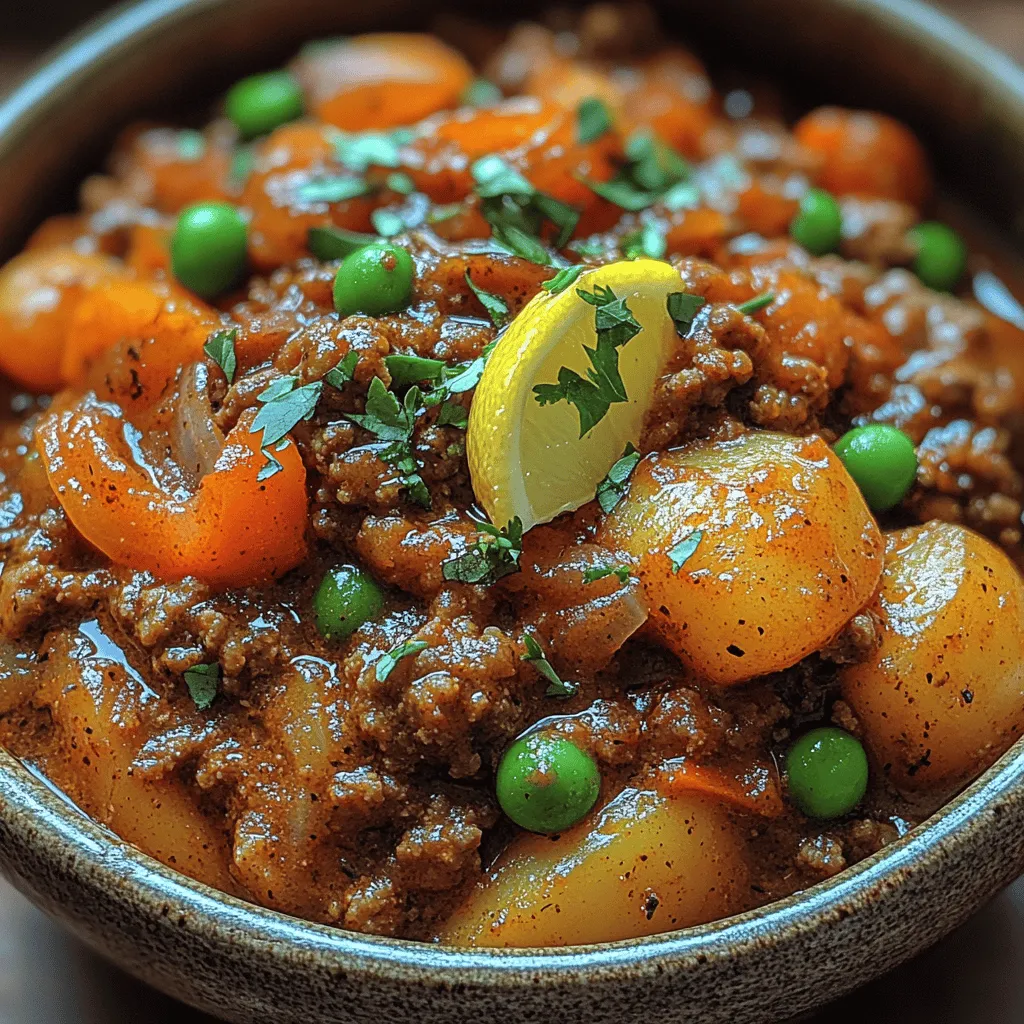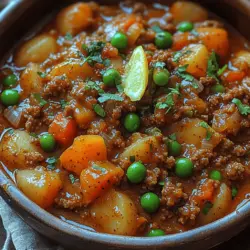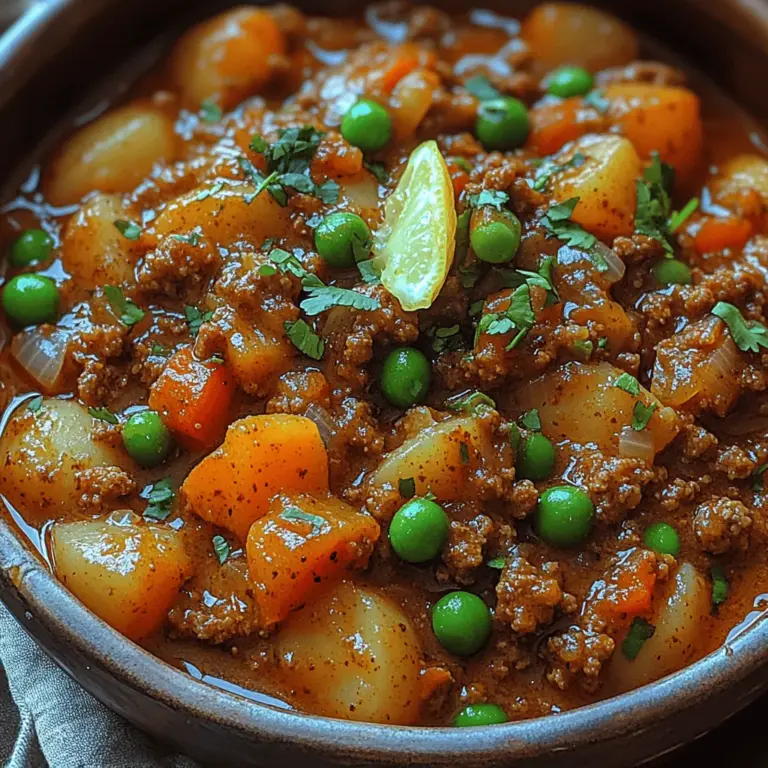Introduction
Qeema, a dish that resonates deeply across various cultures, particularly in South Asia and the Middle East, is a beloved staple that has earned a special place in the hearts—and stomachs—of many. This spiced ground beef delight is not just a meal; it’s a comforting embrace on a plate that brings families together. The use of spiced ground beef in home cooking highlights its simplicity and accessibility, making it a go-to recipe for busy weeknights or special gatherings alike.
The beauty of Qeema lies in its versatility. It can be served with a multitude of accompaniments, from fluffy naan and steamed rice to fresh salads and yogurt. This adaptability allows cooks to tailor the dish to their tastes or dietary needs, ensuring that everyone at the table can enjoy it. Moreover, the comforting flavors that waft through the kitchen while Qeema cooks evoke a sense of nostalgia and warmth, making it a cherished recipe passed down through generations.
In addition to its delightful taste, Qeema packs a nutritional punch. Ground beef is a rich source of protein, essential vitamins, and minerals, making this dish not only delicious but also beneficial for your health. When prepared with a medley of spices and vegetables, Qeema transforms into a wholesome meal that nourishes the body and soul.
Understanding Qeema
At its core, Qeema is defined as finely minced or ground meat, often beef, which is cooked with a blend of spices and vegetables. In South Asian cuisine, it is celebrated for its robust flavors and aromatic spices, making it a quintessential dish in many households. The cultural significance of Qeema extends beyond mere sustenance; it represents a gathering point for family and friends, where stories are shared and memories are created.
The variations of Qeema are as diverse as the regions it hails from. In Pakistan, it is commonly prepared with a combination of spices like cumin, coriander, and garam masala, while some regions might add a touch of green chilies for heat. In India, you might find Qeema prepared with peas, potatoes, or even lentils, showcasing the creativity and adaptation of local ingredients. Each household often has its unique twist on the recipe, making it a personal expression of culinary tradition.
From a nutritional perspective, ground beef is an excellent source of high-quality protein, which is vital for muscle growth and overall health. It also contains significant amounts of iron, zinc, and B vitamins, contributing to a balanced diet. When combined with vegetables like onions and tomatoes, Qeema becomes a well-rounded dish that offers not only flavor but also nourishment.
Ingredients Breakdown
Creating the perfect Qeema begins with selecting the right ingredients. Here’s a detailed look at what you’ll need:
Ground Beef
Choosing the right cut of ground beef is essential for a flavorful Qeema. Look for ground beef with a good fat content—around 80/20 (80% lean meat, 20% fat) is ideal as it provides enough richness without being overly greasy. Higher-fat content can lead to a heavy dish, while very lean beef may result in a drier texture. If possible, opt for grass-fed beef, which is often more flavorful and nutritious.
Spices
The magic of Qeema lies in its spices. Each spice plays a vital role in building layers of flavor:
– Cumin: This spice adds a warm, earthy taste that is fundamental in South Asian cooking. It also aids digestion.
– Coriander: Ground coriander lends a citrusy, slightly sweet flavor that balances the richness of the beef.
– Garam Masala: A blend of spices that can include cardamom, cinnamon, and cloves, garam masala adds warmth and complexity.
– Turmeric: Known for its vibrant color and health benefits, turmeric provides an earthy aroma and anti-inflammatory properties.
– Red Chili Powder: Adjust this according to your heat preference. It gives Qeema a noticeable kick.
Vegetables
Onions, tomatoes, and optional peas are crucial to the dish:
– Onions: These are the backbone of the flavor profile. They should be sautéed until golden brown to enhance their sweetness.
– Tomatoes: Fresh or canned, tomatoes provide acidity and moisture, helping to create a rich sauce that coats the meat.
– Peas (Optional): Adding peas is a common variation that brings sweetness and a pop of color to the dish.
Optional Ingredients
For those looking to make Qeema heartier, potatoes are a popular addition. When diced and cooked alongside the beef, they absorb the spices and contribute a comforting texture, making the dish even more filling.
Preparation Steps
Now that we have our ingredients ready, let’s dive into the preparation process. Each step is crucial for developing the rich flavors that Qeema is known for.
Heating Oil and Tempering Spices
Start by heating about two tablespoons of oil in a heavy-bottomed pan or skillet over medium heat. The type of oil can vary; many prefer using ghee or vegetable oil for cooking due to their high smoke points. Once the oil is hot, it’s time to temper the spices. Add a teaspoon of cumin seeds first and let them sizzle for about 30 seconds until fragrant. This process releases the essential oils in the spices, forming the flavorful base of your Qeema.
Sautéing Onions
Next, add finely chopped onions to the pan. It’s important to sauté the onions until they are golden brown, as this step enhances their natural sweetness and adds depth to the dish. Stir occasionally to ensure they cook evenly and do not burn. This process usually takes about 5-7 minutes, depending on the heat level and the size of your onions.
Adding Garlic and Ginger
Once the onions have achieved the perfect golden color, it’s time to enhance the flavor profile further by adding minced garlic and ginger. These aromatic ingredients should be added right after the onions have browned. Sauté them for an additional minute until they become fragrant. Garlic and ginger not only contribute a robust flavor but also offer numerous health benefits, including anti-inflammatory properties and digestive support.
By focusing on these initial steps, you are laying a strong foundation for the rich, comforting flavors that will define your Qeema dish. Each ingredient and each action contributes to the overall experience, ensuring that your final product is not just a meal, but a delightful culinary journey. In the next section, we will continue with the remaining preparation steps to complete this delicious spiced ground beef delight.

Incorporating Tomatoes and Chilies: Balancing Acidity and Heat
The addition of tomatoes and chilies is a crucial step in preparing Qeema. Tomatoes not only add a rich texture but also bring a necessary acidity that balances the savory flavors of the ground beef. Start by dicing 2-3 medium-sized ripe tomatoes. If you prefer a smoother sauce, you can blend the tomatoes before adding them to the mixture.
When it comes to chilies, you can choose from various types depending on your heat tolerance. Green chilies are traditional and provide a fresh, bright heat, while red chili powder can add depth and warmth. Begin with one or two finely chopped green chilies for a milder version, adjusting according to your preference. When you add these ingredients to the pan, allow them to cook until the tomatoes break down and blend with the spices, creating a rich, fragrant base for your dish.
Mixing in Spices: Techniques for Proper Cooking and Flavor Infusion
Spices are the heart of Qeema, and proper incorporation is essential for a well-rounded dish. Common spices include cumin seeds, coriander powder, turmeric, garam masala, and salt. Start by heating 2-3 tablespoons of oil in your pan and adding a teaspoon of cumin seeds. Allow them to sizzle until they turn golden, releasing their aroma. This technique, known as tempering, enhances the flavor of your spices.
Next, add your ground spices—coriander, turmeric, and salt—and stir them into the oil. The key here is to cook the spices for a couple of minutes before adding the tomatoes and chilies. This method allows the spices to bloom, releasing their oils and intensifying their flavors. Once the mixture is fragrant, add your tomatoes and chilies, stirring well to combine everything.
Cooking the Beef: Best Practices for Browning and Seasoning
After your tomato and spice mixture has cooked down, it’s time to add the ground beef. For Qeema, using a good quality ground beef is crucial; aim for a blend with a bit of fat for added flavor and moisture. Add 500 grams of ground beef to the pan and break it up with a spatula.
Cook the beef on medium-high heat, stirring frequently, until it is browned and cooked through. This browning process is essential not only for flavor but also for texture. Ensure that the beef is well-seasoned; taste and adjust the seasoning as needed, considering that the flavors will deepen as the dish simmers.
Adding Peas and Potatoes: Tips for Texture and Taste
To elevate your Qeema, consider adding green peas and diced potatoes. These ingredients provide texture and a bit of sweetness, balancing the spiciness of the dish. If using potatoes, choose medium-sized ones and cut them into small cubes to ensure they cook evenly.
You can add about a cup of frozen or fresh peas and 1-2 medium potatoes (peeled and diced) to the pan after the beef has browned. Gently fold them into the meat mixture and let them cook for a few minutes. Then, add water—enough to cover the contents—and bring the mixture to a boil. Reduce the heat to low, cover, and let it simmer until the potatoes are tender, approximately 20-25 minutes. This slow cooking process allows all the flavors to meld beautifully.
Final Touches: Importance of Garnishing and Acidity
Once your Qeema is cooked, it’s time for the final touches. A squeeze of fresh lemon juice or a sprinkle of amchur (dried mango powder) can elevate the dish, adding brightness and acidity that complements the rich flavors.
Before serving, garnish your Qeema with chopped fresh cilantro or mint, which adds a fresh, aromatic element. Consider adding thinly sliced green chilies or a drizzle of yogurt for a cooling effect. These finishing touches not only enhance the flavor but also make your dish visually appealing.
Serving Suggestions
Traditional Accompaniments: Naan, Rice, or Roti
Qeema is traditionally served with naan, rice, or roti. The soft, pillowy texture of naan is perfect for scooping up the flavorful meat, while basmati rice offers a fragrant and light base that absorbs the rich sauce beautifully. Roti provides a wholesome, whole-grain option that pairs wonderfully with the spiced ground beef.
Side Dishes: Yogurt or Raita for Cooling Contrast
To balance the spice and richness of Qeema, serve it with a side of yogurt or raita. Raita, made from yogurt mixed with diced cucumbers, tomatoes, and spices, offers a refreshing contrast that cools the palate. This combination not only enhances the meal but also adds an extra layer of flavor.
Creative Serving Ideas: How to Personalize Your Plate
Feel free to get creative with your serving! Consider creating a Qeema platter, where you serve the dish alongside various toppings like pickled onions, sliced green chilies, and fresh herbs. You can also make Qeema wraps using tortillas or naan, adding salad greens and a drizzle of yogurt for a tasty handheld meal.
Common Variations of Qeema
Vegetarian Alternatives: Using Lentils or Meat Substitutes
For those looking for a vegetarian version of Qeema, lentils or meat substitutes can be excellent choices. Use cooked lentils—like red or green lentils—as a base, following the same spice and cooking principles. Alternatively, plant-based ground meat options can mimic the texture and flavors of traditional Qeema, making it accessible for everyone.
Regional Adaptations: Spices and Ingredients Used in Different Cultures
Qeema varies significantly across regions; in some cultures, it may include unique spices or additional ingredients. In South Asia, for example, you might find variations that incorporate regional spices like ajwain or fenugreek. Exploring these adaptations can introduce you to new flavors and cooking techniques.
Cooking Methods: Instant Pot, Slow Cooker, and Stovetop Variations
While traditional stovetop cooking is common, you can also prepare Qeema in an Instant Pot or slow cooker. In an Instant Pot, sauté your spices and meat using the sauté function, then add the tomatoes and vegetables, and pressure cook for about 15 minutes. For a slow cooker, brown the beef separately, then add everything to the slow cooker and let it simmer on low for 6-8 hours. Each method offers a slightly different texture and flavor profile, so feel free to experiment.
Tips for Perfecting Qeema
Adjusting Spice Levels: Tailoring the Heat to Personal Preference
Spice tolerance varies from person to person, so it’s essential to adjust the heat levels in your Qeema. Start with fewer chilies and spices, and taste as you go. You can always add more if you prefer a spicier dish, but it’s challenging to tone down the heat once it’s added.
Making It Ahead: Storage and Reheating Suggestions for Meal Prep
Qeema is an excellent make-ahead option. Prepare a larger batch and store it in airtight containers in the refrigerator for up to 3 days or freeze it for longer storage. To reheat, thaw frozen Qeema overnight in the refrigerator and gently heat it on the stovetop, adding a splash of water if needed to maintain moisture.
Leftover Ideas: Transforming Qeema into Other Dishes Like Wraps and Casseroles
Leftovers can be transformed into various delicious dishes. Use Qeema as a filling for wraps or stuffed peppers, or layer it in a casserole with cheese and vegetables for a hearty meal. You can also mix it into pasta for a unique twist, showcasing the versatility of this flavorful dish.
Conclusion
Making Qeema is a rewarding culinary experience that combines simplicity with a rich tapestry of flavors. With its spiced ground beef base and endless possibilities for customization, this dish is perfect for both weeknight dinners and special gatherings. Whether you stick to traditional flavors or experiment with new ingredients, the joy of cooking and sharing Qeema with loved ones is a truly enriching experience. Embrace the process, try new variations, and let your creativity shine in the kitchen.

